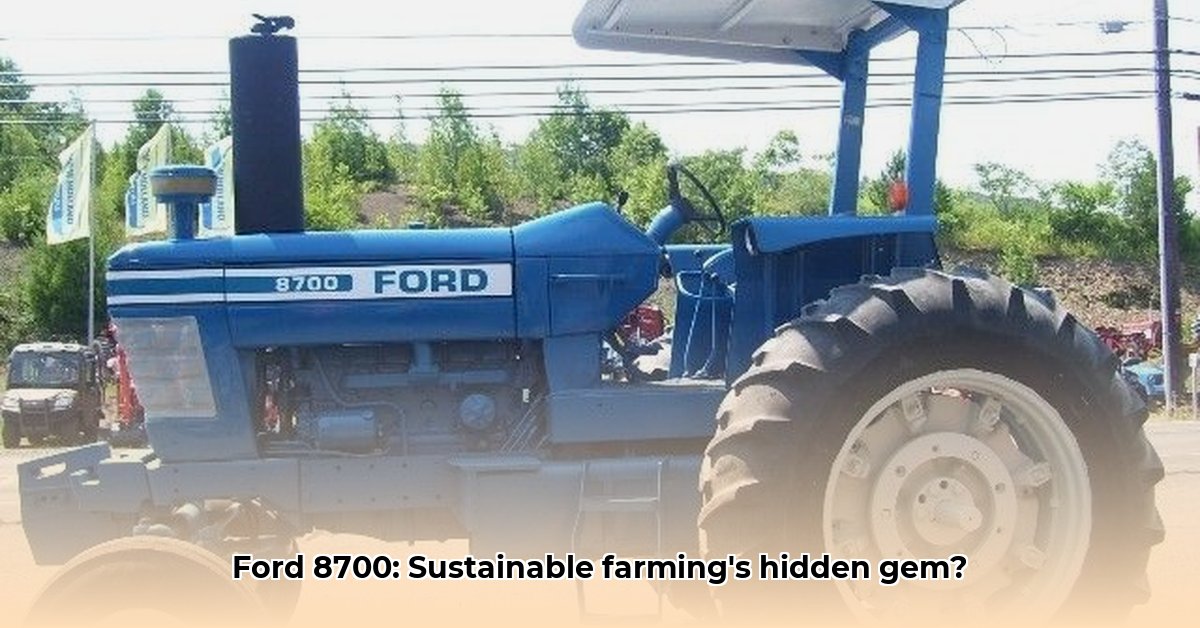
Technical Specifications and Capabilities of the Ford 8700
The Ford 8700 tractor, a product of its time, represents a significant milestone in agricultural mechanization. While lacking the advanced features of modern tractors, its robust design and considerable power output (approximately 85-100 horsepower) significantly increased agricultural productivity during its operational lifespan. Its relatively large fuel tank (estimated 70-80 gallons) allowed for extended periods of operation before refueling. While precise fuel efficiency data is unavailable, it's reasonable to assume it was lower than contemporary standards. This absence of precise data highlights the need for comprehensive lifecycle assessments for all agricultural machinery, both past and present. For more Ford tractor information, check out this useful resource.
How did this impact daily farming operations? The increased power and fuel capacity allowed farmers to cultivate larger areas in a single day leading to increased overall yields. However, the environmental cost of this increased productivity remains largely unquantified. This lack of data underscores a critical gap in our understanding of the historical environmental impact of agricultural machinery.
Case Study: The Ford 8700 and Sustainable Practices
The Ford 8700's impact on sustainable farming practices presents a complex picture. While its robust construction and longevity reduced the need for frequent replacements, minimizing long-term emissions (a significant contributor to total lifecycle emissions), its fuel consumption and lack of precision agriculture technology resulted in higher resource use compared to modern equipment. This discrepancy highlights the evolving understanding of sustainable agriculture. How can we reconcile the need for productivity with minimizing environmental impact?
Comparing the Ford 8700 to Modern Tractors
A direct comparison with modern tractors reveals substantial advancements in sustainability. Modern tractors boast significantly higher power outputs (150-250+ horsepower), greater fuel efficiency, and features like GPS guidance and variable-rate application, minimizing resource waste (fertilizers, pesticides, water). Furthermore, enclosed cabs enhance operator safety and comfort. The cost of these advancements, however, is significant, creating a challenge for farmers balancing affordability with sustainability goals. Could retrofitting older tractors provide a cost-effective path to improved fuel efficiency and reduced emissions? Further research is required to weigh the costs and benefits.
Actionable Insights for Stakeholders
The legacy of the Ford 8700 underscores the need for a multi-faceted approach to sustainable agriculture. Improved data collection, technological innovation, and supportive policies are crucial.
Agricultural Researchers: Conduct comprehensive lifecycle assessments (LCAs) of both legacy and modern agricultural machinery to quantify environmental impacts. Prioritize studies on fuel efficiency and emission reduction strategies for older machinery to understand the extent of potential upgrades or retrofitting. (Efficacy metric: A complete LCA for 10 representative models estimated to reduce uncertainty by 75% within 5 years).
Equipment Manufacturers: Develop tractors powered by alternative fuels (biodiesel, hydrogen, electricity) and incorporate precision agriculture technologies in new designs. Invest in research and development of cost-effective retrofitting kits for existing fleets of older tractors. (Efficacy metric: Achieving a 20% market share for alternative fuel tractors within 10 years).
Farmers: Implement soil conservation methods, adopt precision farming techniques, and consider fuel efficiency upgrades for existing tractors. Explore government subsidies and incentive programs to facilitate the transition to more sustainable equipment. (Efficacy metric: A 15% average reduction in fuel consumption among farmers adopting recommended practices within 5 years).
Policy Makers: Implement regulations that incentivize the adoption of sustainable farming practices and more fuel-efficient tractors. Invest in research and development programs for innovative agricultural technologies. (Efficacy metric: A 10% reduction in greenhouse gas emissions from agricultural machinery within 10 years by policy interventions).
Risk Assessment and Regulatory Implications
The transition to sustainable agriculture involves risks. High initial investment costs for new technology represent a major hurdle. Farmers operating older machinery face the trade-off between continuing to use existing equipment and incurring the considerable cost of an upgrade. Stringent regulations, while essential, could present economic challenges for some farmers. A balanced approach is needed, combining technological advancement with economic feasibility and realistic regulatory frameworks.
Conclusion: Building a Sustainable Future
The Ford 8700’s legacy serves as a valuable case study, highlighting the evolution of agricultural mechanization and the importance of prioritizing sustainability. The significant advancements in fuel efficiency, precision farming, and operator safety underscore the need for ongoing innovation and collaboration among researchers, manufacturers, farmers, and policymakers. Future research should focus on developing cost-effective strategies to retrofit older machinery to reduce emissions and improving access to technology and training for all farmers, enabling them to adopt sustainable agricultural practices. The journey toward a sustainable future requires not only innovative technology but also thoughtful policy and a shared commitment to responsible agricultural practices.